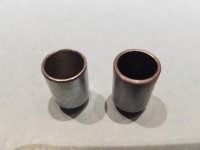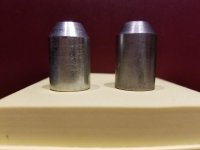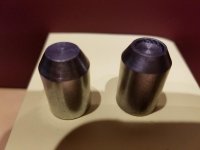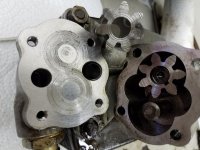Yesterday afternoon I posted:
It's back together with a new oil pump and spindle, new pressure relief valve and spring, new rod bearings, new thrust washers and a new center main bearing.
I spun it over with the plugs out and oil pressure came up after what seemed like five minutes but was probably only 15 seconds. With plugs in the oil pressure is 40 psi at idle and 50 psi at 2K. I'm trusting that all is good and taking it out for a ride in a few minutes. Fingers still crossed, but all seems good.
During that ride, once the engine came up to operating temp of 180 the oil pressure needle began acting erratically during deceleration and at idle. Whereas In the past the oil pressure would fall off gradually by about 10-15 psi from maximum during deceleration, the needle was dropping very quickly whenever I took my foot off the throttle, and was falling to 20 psi--and sometimes less--at idle. Clearly something was wrong!
This morning I drained the oil that I put in yesterday and inspected it for any debris--NONE. I removed the spin-on filter and cut it apart to inspect the filter medium--it too was clear of any debris. I began to suspect that the new oil pressure release valve was not closing all of the way, allowing oil to bypass it and giving lower readings, so I decided to remove and inspect it as well as the passage in which it operates (though I had done this yesterday prior to installing the new valve).
When I disassembled the engine last week I used a 1/2"-13 tap and with finger pressure engaged the inside diameter of the oil release valve and extracted it from the passage. This morning, however, that same tap did not seem to be working on the new valve. I finally got the valve out using a tap with a slightly different taper and when I compared the new valve to the old I saw that there were some slight differences: while the outside diameter of the two valves measured the samec the new valve was made of much thinner material--.0047" versus .0057", which explained why the ID's were different and I could not extract the new valve with the same tap as worked on the old one. See the attached photo--new valve on left.
I reassembled the relief valve using the old part, spun on a new filter and refilled the engine with the same oil. On cold startup the oil pressure was about 5 psi higher than yesterday, varying between 40 to 60 psi from idle to 2500 rpm's +. I drove the car for an hour and at OT of 180 the oil pressure held at 55-60 psi at constant throttle and 35 psi at idle. This conforms to past performance and all seems right!
I can only conclude that the thinner wall construction of the new valve allowed it to expand more when heated--just enough to allow it to jam in its passageway, not seat fully, resulting in lower OP. The Lesson Learned is not to assume anything, especially that new parts are the same as old ones!

 Hi Guest!
Hi Guest!

 smilie in place of the real @
smilie in place of the real @
 Pretty Please - add it to our Events forum(s) and add to the calendar! >>
Pretty Please - add it to our Events forum(s) and add to the calendar! >> 




